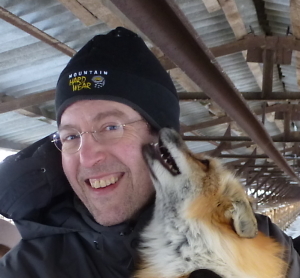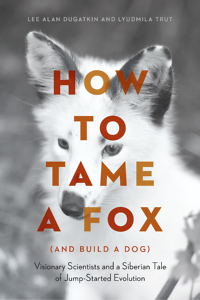Building a Dog
Lee Alan Dugatkin and Lyudmila Trut tell the full story of the famous Siberian fox study
In 1952, a Soviet geneticist named Dmitri Belyaev initiated a now-famous experiment to create tame foxes. His theory was that a wild species could become fully domesticated through selective breeding—no need to wait eons for natural selection to do the job. It was a revolutionary idea, but Belyaev turned out to be right. Within an astonishingly short time, his study produced foxes as reliably gentle and human-bonded as any family pup. In How to Tame a Fox (and Build a Dog), Belyaev’s colleague Lyudmila Trut and evolutionary biologist Lee Alan Dugatkin give a detailed history of the Siberian fox study and explore its importance in understanding how a few species became so closely allied with humans, as well as how humans themselves might have become “domesticated apes.”
 Belyaev’s experiment began during Stalin’s era, and it was undertaken in secret, at considerable risk to the geneticist and his first collaborator, Nina Sorokina. At the time, Belyaev was the lead scientist for the highly lucrative national fur industry, and he commanded great respect in his field. Nevertheless, the type of study he conceived was prohibited by Stalin’s chief science adviser, a charlatan named Trofim Lysenko who had launched a “vehement crusade” against genetics research. Defying Lysenko’s ban took more than professional courage. Belyaev’s older brother, Nikolai, was executed in 1937 for pursuing his own work in the field, and Nikolai’s wife and child vanished.
Belyaev’s experiment began during Stalin’s era, and it was undertaken in secret, at considerable risk to the geneticist and his first collaborator, Nina Sorokina. At the time, Belyaev was the lead scientist for the highly lucrative national fur industry, and he commanded great respect in his field. Nevertheless, the type of study he conceived was prohibited by Stalin’s chief science adviser, a charlatan named Trofim Lysenko who had launched a “vehement crusade” against genetics research. Defying Lysenko’s ban took more than professional courage. Belyaev’s older brother, Nikolai, was executed in 1937 for pursuing his own work in the field, and Nikolai’s wife and child vanished.
But the large fur farm outside Talinn, Estonia, where Sorokina oversaw the breeding program provided excellent cover for Belyaev’s illicit research. The initial work could be explained away as part of an effort to improve pelts and increase the number of offspring. Sorokina’s task was straightforward enough: Choose the calmest, least fearful foxes and let them breed; then breed the calmest offspring of each succeeding generation. Belyaev was convinced that selecting for tameness was the key to the whole process of domestication. The traits generally shared by domesticated animals, including persistent juvenile features, piebald coloring, and speeded-up reproductive cycles, would follow from the primary characteristic of welcoming and even seeking human contact.
Following Stalin’s death and the diminishment of Lysenko’s influence, the fox experiment was moved to a new facility in Novosibirsk, and Belyaev hired Trut to pursue the day-to-day work of breeding the animals and recording their evolution—and there was much to record. Trut’s charges soon exhibited startling, doglike qualities in both appearance and behavior. One particularly human-bonded fox, Pushinka, after being moved with her offspring into a homelike setting shared with Trut and her research assistants, began to guard her people in a distinctly un-foxlike way:
Pushinka let out a short series of barks. Aggressive foxes sometimes made short, menacing sounds at people who approached their cages. This was different. Pushinka hadn’t been approached, she had gone in pursuit to bark at someone. She sounded just like a guard dog. Lyudmila immediately thought, dogs bark to protect their humans, foxes do not.
This radical transformation of the foxes supported Belyaev’s theory of destabilizing selection. It hadn’t been brought about by genetic mutation, which could not have happened in such a short evolutionary window. Rather, selecting for tameness, and thus changing the foxes’ environment and social interactions, had “destabilized” their gene expression patterns. The pattern of expression that had served them well as wild foxes didn’t suit their tame existence, and in just a few generations they adapted to new conditions. Hormone studies and gene sequencing have borne this out.
 Dugatkin and Trut enrich the story of the study itself with asides on its value in solving a number of scientific mysteries, including the mechanism of gene expression and the roots of animal behavior. It also suggests fascinating possibilities for the evolution of human beings. Belyaev, who died in 1985, speculated that early humans might well have domesticated themselves through the same process that tamed his foxes. As they began to come together in larger groups, self-selective mating for calmness and sociability would have served them well and in turn fueled their physical and cognitive development. Primatologists have been intrigued by the idea and believe this same process may currently be underway among the famously peaceable bonobos.
Dugatkin and Trut enrich the story of the study itself with asides on its value in solving a number of scientific mysteries, including the mechanism of gene expression and the roots of animal behavior. It also suggests fascinating possibilities for the evolution of human beings. Belyaev, who died in 1985, speculated that early humans might well have domesticated themselves through the same process that tamed his foxes. As they began to come together in larger groups, self-selective mating for calmness and sociability would have served them well and in turn fueled their physical and cognitive development. Primatologists have been intrigued by the idea and believe this same process may currently be underway among the famously peaceable bonobos.
Trut is now in her eighties, and continues her work with the foxes in Novosibirsk, despite a period of terrible hardship after the dissolution of the Soviet Union. According to her, Belyaev’s greatest unrealized desire was to write a book for laymen explaining “why we have these animals around us, why they are the way they are.” How to Tame a Fox essentially is that book Belyaev never wrote—intelligent, accessible, and engaging. It’s a story of courage as well as genius, and a reminder of the enormous value of a scientific curiosity.

Maria Browning is a fifth-generation Tennessean who grew up in Erin and Nashville. A graduate of Mount Holyoke College, she has attended the Clothesline School of Writing in Chicago, the Moss Workshop with Richard Bausch at the University of Memphis, and the Sewanee Writers’ Conference. She lives in White Bluff.


